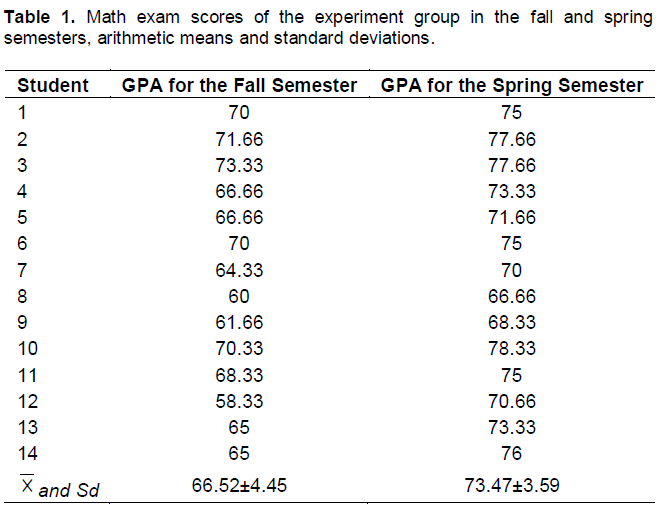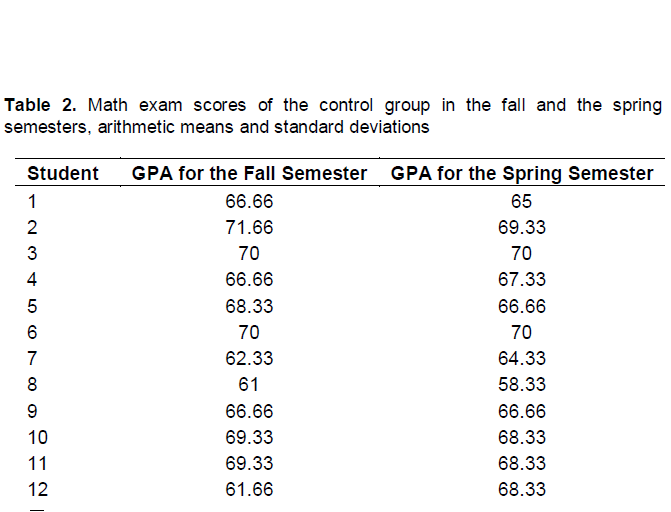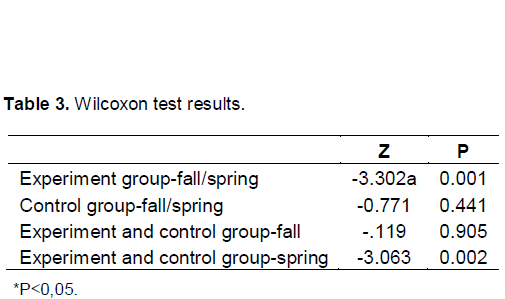Full Length Research Paper
ABSTRACT
The purpose of the study is to explore the impact of chess instruction for visually impaired children on math achievement. The study group consists of a total of 26 visually impaired students from inclusion classes in inclusive secondary schools of MoNE (Ministry of National Education), 9 male and 5 female students in the experiment group and 8 male and 4 female students in the control group. The experiment group consisted of those who were trained for chess over a 12 week- period (one day a week, 4 h) as of the semester break and the control group consisted of those who were never trained for chess. Math scores of the both groups during the fall and the spring semesters which were the recorded scores in the “e-school” system of the Provincial Directorate for National Education were verbally learned from those who were included in the study. Arithmetic mean and standard deviation were employed in the statistical analysis of the data, and the Wilcoxen Test was used for the assessment of the participants’ progress. For the fall semester, arithmetic mean and standard deviation of the experiment group were 66.52±4.45, and those of the control group were 66.96±3.55. For the spring semester, arithmetic mean and standard deviation of the experiment group were 73.47±3.59, and those of the control group were 66.88± 3.23. In the comparison of the fall and the spring semesters of the experiment group, there was a significant difference at the level of 0,001 (p<0,05) while there was no significant difference at the level of 0,441 in the control group (p>0,05). In the comparative study of the experiment group and the control group in both semesters, there was no significant difference at the level of 0,905 for the fall semester (p>0,05) while there was a significant difference at the level of 0,002 for the spring semester (p<0,05). As a result, chess instruction for the visually impaired has proven to be influential on math achievement.
Key words: Visual impairment, chess, mathematics.
INTRODUCTION
Chess is considered to be an educational activity that has many different types of elements and that consists of contradictory movements, based on attacks. Educationally speaking, it is obvious that chess improves creativity, reading and intelligence, reasoning and thinking skills. It also contributes to imagination. The results of the study have shown that chess has a positive effect on student learning (Köksal, 2006). Chess has also been frequently employed in multiple intelligence studies (Arl?, 2004). development Research on chess has shown that chess players have improved their mental capacity such as creativity, critical thinking, decision making and problem solving and chess has positively influenced academic and social achievements of individuals and has been explored as a sport of good time management (www.talimterbiye.mebnet.net). Chess is a mental game which is suggested for children with learning difficulty, attention deficit and hyperactivity disorders.
The number of chess pieces and that of squares are properly arranged in mathematical terms and the qualities of pieces match mathematical positioning. It has been observed that those who consider chess in mathematical terms and play by attaching numerical values are more successful in the game than others (http://www.eokulegitim.com/).
Chess is a game of infinite probabilities and strategies. In general, calculations of probabilities and choosing the right strategy have priority during the game. Constantly imagining all possible positions in the game, calculation of ten or more movements by many chess masters and their awareness of which rival will have the advantage of the upcoming position make chess completely abstract and built on calculation skills. Mathematics has similar features to chess in that it contains abstraction and calculations. Scientific research has supported such a relationship. Many studies suggest that children use their mind better than ever during a game of chess and that chess improves mathematical skills and academic performance (Gobet and Campitelli, 2005; Sad?k, 2006).
Chess is primarily a mind sport and a board game that needs immobility. As a result, it removes the risk of physical difficulties in sports and thus is one of the most popular activities for the visually impaired in their leisure time. Chess is not only considered as a sport and a recreation activity for the visually impaired, but is also viewed as a contributor to their education since it has multi academic effects such as analytical thinking as a game strategy, problem solving and applying mathematical concepts.
METHODOLOGY
Study group
The study group consisted of voluntary visually impaired students (n=26) in secondary school inclusion classes of MoNE. Those students were divided into two: those who were trained for chess (9 male and 5 female students) and those who were not (8 male and 4 female students). The former group was taught chess over a 12 week period (once a week, four hours). The control group consisted of the other students.
Collection of data
Math scores of the both groups during the fall and the spring semesters which were the recorded scores in the “e-school” system of the Provincial Directorate for National Education were verbally learned from those who were included in the study.
Analysis of data
In the statistical analysis of the math scores in the fall and the spring semesters, the Wilcoxon Test was employed to find out arithmetic means, standard deviations and the differences between the two semesters and the groups.
RESULTS
Arithmetic means, standard deviations and the Wilcoxon Test results for the math courses in the fall and spring semesters of the visually impaired students included in the study are given in Table 1.
Arithmetic means of the end of the year scores of the experiment group were 66.52 for the fall semester and 73.47 for the spring semester (Table 2).
Arithmetic means of the end of the year scores of the control group were 66.96 for the fall semester and 66.88 for the spring semester (Table 3).
According to the Wilcoxon Test results, there was a significant difference between the arithmetic means of the math scores of the experiment group in the fall semester and the spring semester (P<0,05). There was no significant difference between the arithmetic means of the math scores of the control group in the fall semester and the spring semester (P<0,05). There was no significant difference between the experiment group and the control group in the comparison of the math scores in the fall semester (P<0,05). There was a significant difference between the experiment group and the control group in comparison of the math scores in the spring semester (P<0,05).
DISCUSSION AND CONCLUSION
In this section, assessment of statistical analyses of GPAs of the 14 students in the experiment group who were trained for chess and of the 12 students in the control group is presented.
In the study, there was a significant difference in the comparison of the fall and the spring semesters for the experiment group (p<0,05) while there was no significant difference in the control group (p>0,05). There was no statistically significant difference between the experiment group and the control group for the fall semester in the comparison of the both semesters (p>0,05) whereas there was a significant difference for the spring semester (p<0,05).
In Turkey, there have not been studies on the impact of chess instruction for the visually impaired on math



achievement. In a study conducted by Sad?k (2006), it was observed that problem solving skills of 4th and 5th graders in elementary schools with counting numbers were higher for those who knew how to play chess. In another unpublished study conducted in 2011 with 5th, 6th, 7th and 8th graders in elementary schools, it was seen that there were significant correlations between skill levels and chess levels in the comparison of numerical and verbal skill levels and chess levels of the students (Karakaya, 2012).
In studies that examined problem solving skills of elementary students who played chess and of those who did not, it was found that hasty approach levels and avoidant approach levels of the students who did not play chess were higher when compared to the ones who could play the game and planned attitude levels of the chess players were found higher when compared to the non-players (Erhan et al., 2009).
In experiments by Dr. Yee Wang Fung, a faculty member of the Chinese University of Hong Kong, with students at numerical departments of the university, in the years 1977- 1979, it was observed that those who were trained for chess had an increase of 15% on average in their math and science test scores. Barrett and Fish (2011) found an increase in the math scores of the students who attended the 30 week chess training program. They emphasized chess had significant contributions to increasing math achievement of students with special education needs. In a study that was aimed at exploring the impact of chess instruction for pupils with learning difficulty on math achievement, they claimed chess was a significant contributor to those with learning difficulty (Scholz et al., 2008). In their study, Hong and Bart (2007) found chess instruction for underachievers had positive effects on cognitive development.
Again, in a study conducted in Texas, USA in the years 1994-1997, it was found that students who joined chess clubs between 3rd and 5th grades made two fold progress than the others in reading and mathematics (Köksal, 2006). Garcia (2008) found there was a significant difference in math performance between Spanish 4th graders who were trained for chess in the chess club and those who were not instructed.
In a chess training program by Cheryl Coles, the principal of the state school no: 68 in Bronx District, New York in 1997, it was shown that there was an increase of 11.2% in reading performance of the students who were trained for chess and an increase of 18.6 % in their math scores over a year (http://www.tsf.org.tr).
Frank conducted an experimental study with a total of 92 students aged 16-18 in Democratic Republic of the Congo (in Zaire) in the years 1973-1974 in order to explore the impact of chess on various skills such as intelligence, creativity, numerical and verbal skills. As a result of the study, it was concluded that those who were trained for chess had more effective levels of intelligence, creativity, reasoning, quick and accurate grasping and shapes and spatial understanding skills and that they developed those more when compared to the control group (Cited by Karakaya, 2012)
A study was conducted with 437 5th graders in New Brunswick, Canada in the years 1989-1992. It was con-cluded that those who were most intensively trained for chess were found more successful in problem solving in mathematics among the groups of students divided into three according to course load (http://www.tsf.org.tr).
As a result of the study, it was explored that chess increased math achievement of the visually impaired because of analytical thinking and problem solving qualities.
According to these results, there were statistically significant differences in the comparison of math course means of the visually impaired students in the experiment group for the fall and the spring semesters and in the comparison of arithmetic means and standard deviations of the spring semester math scores of the control group and the experiment group (p<0,05). There was no significant difference in the comparison of arithmetic means and standard deviations of the fall and the spring semester math scores of the control group and in the comparison of the fall semester scores of the experiment group and the control group (p>0,05). According to these results, chess contributed to math achievement of the visually impaired.
RECOMMENDATIONS
1.There should be more groups to study with.
2.Progress of chess players in other courses could be tracked.
3.Chess problems including creative thinking could be applied in math courses.
4.Chess, when considered as a positive contributor to word problems and problem solving skills in math courses, could be included in pre-school, elementary school, secondary school and high school curricula and higher education programs.
5.Chess can be instructed for every visually impaired student as a most beneficial leisure time activity.
CONFLICT OF INTERESTS
The author(s) have not declared any conflict of interests.
REFERENCES
|
Arlı Ö (2004). Social studies course impact of learning environment based on multiple intelligence activities for the study unit entitled "turkey, our beautiful country" on 5th graders' achievement. Yıldız teknik university. Institute of Social Sciences. Department of education programs and instruction. Master's thesis. Ä°stanbul. Turkey |
|
|
|
|
|
Barrett DC, Fish WW (2011). Our move: using chess to improve math achievement for students who receive special education services, int. J. Special Educ. 26:3. |
|
|
|
|
|
Gobet F, Campitelli G (2005). Educational benefits of chess instruction: A critical review, [To appear in T. Redman (in press), Education and chess], S:1-28 |
|
|
|
|
|
Erhan E, Hazar M, Tekin M (2009).Examining problem solving skills of elementary school students who play or do not play chess. Atabesbd. 11(2): 1-8 |
|
|
|
|
|
Hong S, Bart W M (2007). Cognitive effects of chess instruction on students at risk for academic failure. Intl. J. Special Educ. 22(3):89-96.) |
|
|
|
|
|
Karakaya M (2012) www.vizyon21yy.com/Ust_Duzey_Dusunme_Becerilerinin_Kazandiri, Date of Access 15,08,2014 |
|
|
|
|
|
Köksal A (2006) Chess in education, journal of educational sciences mehmet akif ersoy university.P 17-26 |
|
|
|
|
|
Sadık R (2006). Comparison of word problems and problem solving skills with counting number of chess players and nonplayers at 4th and 5th grades in elementary schools. Abant izzet baysal university unpublished master's thesis.Institute of Social Sciences. Bolu. Turkey |
|
|
|
|
|
Scholz M, Niesch H, Steffen O, Ernst B, Markus L, Witruk E, Schwarz H (2008). Impact of chess training on mathematics performance and concentration ability of children with learning disabilities, Intl. J. Special Educ. 23:3 |
|
Copyright © 2024 Author(s) retain the copyright of this article.
This article is published under the terms of the Creative Commons Attribution License 4.0